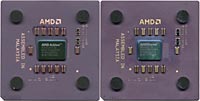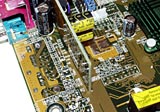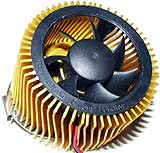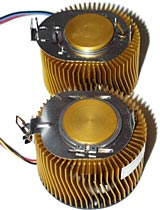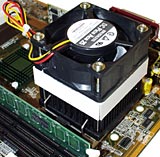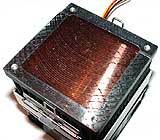
ASUS A7V, Part Deux
Review date: 29 July 2000.Last modified 03-Dec-2011.
Just a few days ago, I checked out the ASUS A7V Socket 462 (a.k.a. "Socket A") motherboard (the review's here), and noted that it was almost the motherboard that hopeful Duron performance-hunters have been waiting for.
It had a space for switches that let you adjust the multiplier of "unlocked" current AMD processors - but there weren't any switches there.
For the details of the multiplier locking saga, check out the original review. Way back then on Monday, I thought that we might have to wait a little while to get the switch-equipped version of this motherboard.
I was wrong.
ASUS realised that they could steal a march on other manufacturers with multiplier-twiddling Socket A motherboards in the pipeline, and got the switch-equipped version of the board out the door in double-quick time. When I first wrote this review it cost $AU324.50 delivered from m'verygoodfriends at Aus PC Market, however they aren't selling it any more.
If you're not interested in overclocking - running your CPU faster than it's supposed to go - then either model of A7V's a great Socket A board. Like all Socket A boards, they work with Athlon and Duron CPUs in the new square-chip form factor.
Here's an Athlon (left) and a Duron (right). At a glance, very similar, and quite similar in performance at a given clock speed, as I'll explain shortly. But they're different in one important respect - the Duron's not multiplier locked.
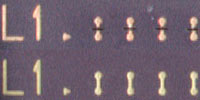
Here are the tiny "L1" bridges on the top of each processor. The Athlon's at the top; its bridges have been laser-cut, which makes it a locked-multiplier processor. You can unlock them with judicious application of conductive ink or adhesive (or, I would imagine, by burnishing on some flecks of gold leaf). Or you could just buy the Duron, whose un-cut bridges are at the bottom of the picture.
Retail Durons are alleged to have a locked multiplier; this one's an Original Equipment Manufacturer (OEM) CPU, commonly available in retail stores here in Australia, and doesn't.
UPDATE: The fun's over!
According to Aus PC Market, as of now (the start of August, 2000), OEM Durons aren't coming from the factory unlocked any more. This isn't a giant problem, as it's not tremendously difficult to re-join the cut L1 bridges, but it does mean that if you buy an OEM Duron sight unseen with the intention of overclocking it you'll probably now find that you have to do the bridge-joining trick yourself. Check with whoever you buy from to find out what kind you're getting, and find out if they'll re-join the bridges for you; it's a simple but fiddly job.
A7V features
Even if you don't care about all this CPU locking malarkey, the A7V's a nifty motherboard. It's got twin IDE controllers (four connectors, up to eight drives!), with the second controller supporting the ATA-100 standard. Which doesn't mean a lot, but sounds good.
There's five PCI slots, one not-so-useful Audio Modem Riser (AMR) slot, three RAM slots, two USB ports built into the motherboard, and a connector for two more ports.
The extra USB ports are a common enough feature these days, but some penny-pinching motherboard makers don't include the cable and backplate with the actual ports on it. ASUS do.
You also get a stick-on thermal probe with the motherboard. AMD processors don't have the internal thermal monitoring circuitry that Intel CPUs do, so if you want to keep tabs on your processor heat, you have to make do by sticking the probe somewhere you hope will be somewhat representative of the real CPU temperature.
And, like most motherboards these days, you can configure various features, including CPU and RAM tweaks, in the BIOS setup program. ASUS call this "Jumper Free", which is accurate enough; when fooling with CPU speed settings, you don't have to keep delving back into the computer to shift tiny plastic blocks around.
There are two big differences between the original A7V (board revision 1.00) and this multiplier-adjust version (revision 1.01). One, the multiplier switches, which I'll get to in a moment. Two, the on-board sound. Or lack of it. The original A7V has built-in audio hardware...
...but the 1.01 board just has blank spaces where it used to be.
For game players, this is actually a plus. Built-in audio isn't rubbish (well, not any more, anyway), but it doesn't have the fancy 3D sound features that game-lovers prefer. If you're going to be using a nifty positional-audio sound card anyway, losing the audio hardware is no loss at all.
The board revision alone doesn't necessarily indicate that you've got the overclock-friendly version; apparently there are v1.01 boards with no switches and on-board sound. I don't, however, think that there are any A7Vs that have the switches and the sound hardware, so just making sure you order a board with no sound ought to guarantee you get the Overclocker's Special.
Testing
I checked the A7V out with a 650MHz Duron. A 600MHz Duron's $AU215; the 650's only 8.3% faster, but more than 20% more expensive at $AU260 or so. When you can fiddle with a processor's multiplier, its default core speed isn't of interest unless faster stock speeds indicate superior core quality, which they don't seem to in Durons so far.
So if you intend to overclock via multiplier changing, you might as well buy the slower Duron. And if you're happy with the CPU's stock speed, you're unlikely to notice the performance difference of a 650MHz unit. But you probably will notice the extra $AU45 you have to spend.
If you've just got to blow some extra money, get a 600MHz Duron and a Bad-Ass Cooler (TM) for it.
If you're running a Duron at stock speed and, thus, stock voltage, there's no reason at all to worry about cooling. Stock Durons run only slightly warmer than stock Celerons, and any old cheapo cooler will be more than adequate to keep them happy, in a case with halfway decent ventilation.
But if you start winding up the CPU speed - and the core voltage, too, to get the processor to run at higher speeds - the processor power rises rapidly, and fancier heat-extraction gadgetry becomes necessary.
But be careful, if you choose to buy a ThermalTake Golden Orb for a Socket A processor at the moment. Yes, you can get them for about $AU33; yes, they look ultra-fabulous; yes, the twist-on clamping mechanism the original Orb uses is both solid and simple; yes, they're quite good coolers for the money. But the twist-on Orbs don't fit on Socket A CPUs properly.
The original Socket 370-type Golden Orb (Socket 370 is Intel's square-CPU form factor) has, recently, become infamous for grinding Durons to death. ThermalTake then released a slightly modified version, meant to take into account the slightly higher position of the Socket A CPU dies in relation to the end clips. But, as it turns out, that cooler grinds CPUs, too.
Most apologetically, ThermalTake are now making an Orb with a conventional clip to hold it onto the socket.
And here it is. The Orb in the foreground is the new kind; the Orb in the background is the old one. The new retainer's held onto the Orb with a chunky circlip, and looks quite different from the old unit, but because of ThermalTake's brief attempt to make a twist-on Socket 462 version, you'll have to be careful if you're buying Orbs sight unseen.
It's still possible to mangle a CPU with the new cooler, by jamming the ratcheting clip down with all your might and wiggling it around, but it's a great deal less likely.
Aus PC Market and, no doubt, other compu-gear purveyors of quality have the new Orbs now, and will supply the right kind for Socket 462 and Socket 370 motherboards, respectively.
You can make older Orbs work on Socket A, by pre-bending the clamp ends to give the cooler some more clearance. But if you try it and hear a sound not unlike a rice cracker being snapped when you twist the cooler onto the CPU, don't say I didn't warn you.
Better cooling
Golden Orbs, when they fit, are good value for money. But the kings of cooling in my humble opinion are still Japanese outfit Alpha. The fact that they sent me a PAL6035MUC cooler for nothing a while ago has absolutely nothing to do with my opinion, of course.
This cooler won't work properly with Intel FC-PGA CPUs, because it doesn't have enough support from the small CPU contact patch to hold it level. Read all about my amusements in this department here.
But the Socket A CPUs have spacer dots built in, and the PAL6035 seems to fit just fine. Some people have reported the dots to be too thick, and cause coolers to make lousy contact with the CPU, but it seemed OK to me. A smear of thermal transfer compound ("heatsink grease") to fill the tiny air gaps between CPU die and ultra-flat Japanese masterpiece of machining, and all was well.
The copper heat spreaders built into the bases of Alpha's better CPU coolers make them ideal for small-die processors like the Socket A and newer Socket 370 Intel units. The small contact patch these processors have with their coolers means that if the cooler's only got an aluminium base, the CPU can have a hard time pumping heat into the heatsink.
Alpha have resellers all over the place - see their list here. But, to my knowledge, nobody stocks a decent selection of their gear here in Australia.
Fortunately, the coolers are surprisingly inexpensive (by Japanese Extreme Computing Gear standards) from the Alpha on-line store, here. A PAL6035MUC's $US31.10 plus shipping, which means the thing'll cost you less than $AU80 landed here in Australia.
You've got to assemble Alpha coolers yourself, but it's just a matter of heaping up the components and driving four screws to build a PAL6035MUC.
Aaaaanyway, the PAL6035MUC works perfectly on Socket A CPUs. The Alpha clip is a little fiddly, but it engages well, holds the cooler firmly, and does not encourage the chip to engage in an atavistic return to a sand-like state.
The A7V helps you here, with its little riser card behind the CPU socket that holds all of the CPU power smoothing componentry. There's no forest of big capacitors around the socket.
Time to use those multiplier switches.
Cranking it up
The only DIP switches you need to fool with to change the A7V multiplier are the six-switch block next to the first IDE controller's connectors.
Here are the switches:
The four-switch block further away from the drive connectors is the hardware Front Side Bus (FSB) adjustment block. You can only change the multiplier if you've got the FSB locked to the 100MHz setting, by turning all four switches on. By default, this block's in the "Jumper Free" mode with all four switches off, which lets you twiddle the FSB in the BIOS setup program.
When you've locked the FSB to 100MHz, you can't change it in the BIOS setup. But you can still tweak CPU voltage, with 0.05 volt increments all the way up to a you'd-better-have-a-good-heatsink 1.85V.
The lunatic fringe of overclocking likes to squeeze out that last few per cent on an Athlon system by setting the multiplier, then goosing the FSB by a few megahertz. But people who don't hear quite so many voices in their heads will be pleased to know that the actual performance difference is trivial. BY definition, the most you're going to get from FSB tweaking is less than 50MHz (for more than that, you just pop the multiplier up another notch), and when you're already running well above 700MHz, 40-odd megahertz difference isn't anything you're likely to notice.
Here are the settings for the other six switches.
Multiplier |
1 |
2 |
3 |
4 |
5 |
6 |
5.0 |
ON |
ON |
OFF |
ON |
ON |
ON |
5.5 |
OFF |
ON |
OFF |
ON |
ON |
ON |
6.0 |
ON |
OFF |
OFF |
ON |
ON |
ON |
6.5 |
OFF |
OFF |
OFF |
ON |
ON |
ON |
7.0 |
ON |
ON |
ON |
OFF |
ON |
ON |
7.5 |
OFF |
ON |
ON |
OFF |
ON |
ON |
8.0 |
ON |
OFF |
ON |
OFF |
ON |
ON |
8.5 |
OFF |
OFF |
ON |
OFF |
ON |
ON |
9.0 |
ON |
ON |
OFF |
OFF |
ON |
ON |
9.5 |
OFF |
ON |
OFF |
OFF |
ON |
ON |
10.0 |
ON |
OFF |
OFF |
OFF |
ON |
ON |
10.5 |
OFF |
OFF |
OFF |
OFF |
ON |
ON |
11.0 |
ON |
ON |
ON |
ON |
ON |
ON |
11.5 |
OFF |
ON |
ON |
ON |
ON |
ON |
12.0 |
ON |
OFF |
ON |
ON |
ON |
ON |
12.5 |
OFF |
OFF |
ON |
ON |
ON |
ON |
You need to know the settings, because they're not in the manual yet. They're actually printed on the motherboard itself, in two little tables, but you'll probably find it less than totally convenient to read those tables after building a computer.
ASUS aren't yet shipping multiplier-adjust A7Vs with a manual to match; you get the manual for the plain integrated-sound version. No matter; all you need are these settings, and to know to set the FSB to 100MHz, and you're in business.
The multiplier numbers relate to the 100MHz FSB; 7.5 therefore gives you a 750MHz CPU, assuming the processor core can handle that speed at the voltage you've set.
Athlons and Durons really run from a 200MHz, speed-doubled bus, so 7.5 is actually 3.75. But AMD decided that increments of 0.5 were confusing enough, and the world didn't need 0.25 settings. Fair enough.
Don't get too excited about that 12.5X top multiplier. It may be attainable with future Socket 462 CPUs, but not with anything on the market today. Unless you're using outrageous sub-zero cooling, you can't expect current Durons to work at anything above 900MHz. And that's definitely pushing it, if you want a stable computer.
"Stable" is, however, a relative term, for overclockers.
Most overclockers are 3D game players, which means they're running Windows 98, because that's the OS you want for maximum 3D graphics performance.
But Windows 98 isn't a very stable operating system. In much the same way that the Taliban aren't big fans of Julian Clary.
Add a computer full of new shiny hardware running the latest Loony Enthusiast Drivers to the already not-so-nice stability of Win98, and a flaky CPU can be lost in the swirl of bluescreens, hangs and nonsense-errors.
Plus, of course, scoring a successful overclock to some outrageous speed is like clocking a magnificent drag racing ET, or having a spectacular golf handicap. There's a big incentive to demonstrate your technical prowess by calling a machine that falls in a screaming heap every 20 minutes "rock solid stable". Thus will all the world know that truly you have, as the youngsters say, da mad skillz.
After all, it's not as if the 17 people that read "Colin Dull's Astonishing Adventures in Overclocking" (as a recent correspondent of mine called such sites) every week can tell whether you're lying or not.
These facts colour my attitude towards people who're eager to tell the world about their rock-solid-stable 900MHz Duron. OK, maybe so. And maybe not.
Don't get your hopes up.
My 650MHz Duron was really and truly stable, for hours on end of system flogging, at any speed up to 800MHz. I had to goose the CPU voltage up to 1.75V for stability at 800MHz, but the Alpha cooler was more than capable of handling the heat increase.
850MHz was troublesome. When the machine started up at that speed and 1.75 volts or higher, it seemed happy as a clam. But if you rebooted it, it wouldn't pass the Power-On Self Test (POST; when your computer beeps, it's just "POSTed"), much less start Windows. Much random fiddling was needed to get it to start up at 850 again.
Such are the mysteries of redlining your processor.
Now, 850MHz is only a 6.25% gain over 800MHz, so the difference isn't worth getting excited about. If you can get 800MHz out of a 600MHz Duron, as seems likely enough, then you've got a highly worthwhile 33% overclock. 900MHz is nicer, but you pays your money and you takes your chance.
So how fast is it?
In synthetic CPU benchmarks, processors with the same basic core architecture but different cache amounts will benchmark the same. Since that pretty much sums up the difference between the Duron and the Socket 462 "Thunderbird" Athlon, it's not surprising that at a given clock speed, they're indistinguishable in thumb-twiddling teeny-tests. This is pretty much irrelevant to the real world, though.
Do real world tests, and the Duron stands up well to its more expensive sibling. At a given clock speed, a Duron will manage roughly 90% of Athlon speed for a lot of tests.
Heavy-duty application tests with heavy cache use will show the Duron at only 85% or so of Athlon speed, but for 3D games, the Athlon may win by only 5%. That depends on the game, the resolution and the graphics card, but I for one wouldn't want to have to pick the difference between identically clocked Durons and Athlons in any entertainment title.
Adding it up
It seems, from other users' reports, that 800MHz is a thoroughly realistic reliable overclock result from any unlocked-multiplier Duron. 850MHz isn't out of the question, and 900MHz might even be possible. But let's say you buy a 600MHz Duron, and only get it to 800. This'll give you 750MHz Athlon grunt for your $AU215.
A real 750MHz Athlon CPU costs more than twice as much as a 600MHz Duron. It'll pretty much level-peg with an 800MHz P-III, which you may or may not actually be able to buy retail at the moment, and which'll probably cost you $AU700 or more if you manage to find one. Rarity keeps the price up.
You've got to factor in the amount of work involved in a motherboard transplant, though.
If you're upgrading an old Pentium II machine, but don't want to rip your whole computer apart to install a new motherboard, you should check out Celerons rather than Durons. With a "slotket" adaptor board, most P-II boards will work fine with Celerons up to the 533 model, the fastest based on the old P-II core.
A plain Celeron 533 (not the 533A, which is the newer P-III based Coppermine 128 model) doesn't have the power of a stock-speed Duron 600, and it costs a little more than the AMD chip too, but as a drop-in upgrade it can't be beaten. Genuine 533MHz Pentium II performance - click.
Forget overclocking - the C-533's already running pretty much as fast as that old core can go - but it's a great no-fuss upgrade nonetheless.
A lot of P-II motherboards can, sometimes after a BIOS update, handle the Celeron 533A, and the faster Coppermine 128 models too. You can get a 566 for less than $AU265, and that'll give you three quarters of Duron 600 performance. Overclock a 533A or 566 to 800-odd megahertz (not something you're likely to pull off with an old motherboard...) and you'll have a CPU only 20-odd per cent off Duron 800 speed.
But if you're buying a new motherboard anyway, a goosed-up Duron is a clearly superior option. And the A7V may be the first of the multiplier-adjust motherboards to hit the market, but it's got all the features most users are likely to need. If you must have an ISA slot or two then you're out of luck, but that's about it for A7V shortcomings, really.
Well, what are you waiting for? Go and get yourself some serious CPU power on the cheap!
